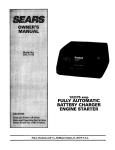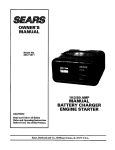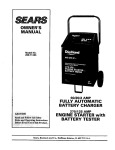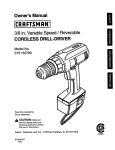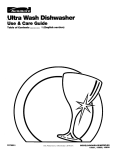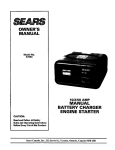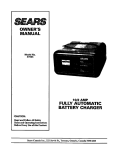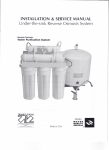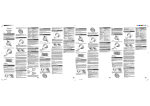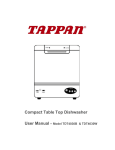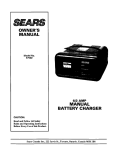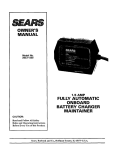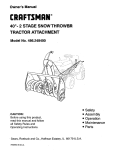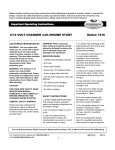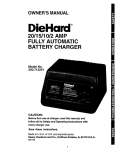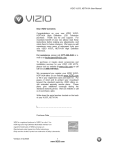Download Sears 200.71201 Owner`s manual
Transcript
S ARS OWNER'S MANUAL Model No. 200.71201 1.5 AMP MANUAL BATTERY CHARGER CAUTION: Read and Follow All Safety Rules and Operating Instructions Before Every USe of this Product. Sears, Roebuck and Co., Hoffman Estates, IL 60179 U.S.A. Table Of Contents Warranty ..................................................................... Important Safety Instructions ................................... Parts ........................................................................... Before Using Your Battery Charger ......................... Plugging it in .......................................................... Using an extension cord ........................................ Preparing your battery to be charged ................... Please read this The Sears model use. This manual these instructions 1 2 3 4 4 4 5 Using Your Battery Charger ..................................... 6 Setting the controls ................................................ 6 Charging your battery ............................................ 6 Calculating charge time ......................................... 8 Maintenance and care ........................................... 9 Troubleshooting ...................................................... 10 Owner's Manual before using your Battery Charger 200.71201 Manual Battery Charger, offers features to accommodate the needs for home will show you howto use your charger safely and effectively. Please read and follow and precautions carefully. Warranty FULL TWO-YEAR WARRANTY If, withintwo years fTomthe date of purchase, this battery charger failsdue to a defect in materials or workmanship, simply RETURN IT TO THE NEAREST SEARS STORE IN THE UNITED STATES, and Sears will repair or replace it, free of charge. This warranty gives you specific legal rights, and you may also have other rights which vary from state to state. Sears, Roebuck and Co., Dept 817WA, Hoffman Estates, IL 60179 Important Safety Instructions - SAVE THESE INSTRUCTIONS • Read all instructions and cautions printed on the battery charger, battery, and vehicle or equipment using battery. • Use charger only on lead-acid type rechargeable batteries, such as those used in cars, trucks, tractors, airplanes, vans, RV's, trolling motors, etc. This charger is not intended to supply power to a low voltage electrical system other than in an automotive application. - • Do not disassemble charger. Take it to a qualified service professional if service or repair is required. Incorrect assembly may result in fire or electrical shock. • To reduce risk of electrical shock, unplug the charger from the outlet before attempting any maintenance or cleaning. • Always charge battery in a well ventilated area. • Use only attachments recommended or sold by manufacturer. The use of attachments not recommended by the manufacturer may result in fire, electric shock, or injury. Help us help you Remember: • Place charger as far away from battery being charged as the charger cables will permit. • Do not expose charger to rain or snow. • Never charge a frozen battery. If battery fluid (electrolyte) becomes frozen, bring battery into a warm area to thaw before you begin charging. • Never allow battery acid to drip on charger when reading specific gravity or filling battery. • Never set a battery on top of the charger. • Never place charger directly above battery being charged. The gases from the battery will corrode and damage the charger. • Never use charger for charging dry-cen batteries that are commonly used with home appliances. These batteries may burst and cause personal injury. Personal Safety • Never touch the battery clamps together when the charger is energized. • Never operate charger if it has received a hard blow, been dropped, or otherwise damaged. Take it to a qualified professional for inspection and repair. • Be sure to position the charger power cord to prevent it from being stepped on, tripped over, or damaged. • Never pull out the plug by the cord when unplugging the charger. Pulling on the cord may cause damage to the cord or the plug. • Do not operate the charger if it has a damaged power cord or plug. Have the cord replaced. Precautions For your own personal safety, please follow the following precautions: • Wear complete eye and clothing protection when working with lead-acid batteries. • Be sure that someone is within range of your voice to come to your aid if needed while you work with or are near a lead-acid battery. • Have plenty of fresh water and soap nearby for use in case battery acid contacts your eyes, skin, or clothing. If this happens, wash immediately with soap and water. Then get medical attention. • Avoid touching your eyes while working with a battery. Acid particles (corrosion) may get into your eyes. If this occurs, flush eyes immediately with running cold water for at least ten minutes. Then immediately get medical attention. • Remove all personal metal Items from your body, such as rings, bracelets, necklaces, and watches while working with a lead-acid battery. A battery can produce a short circuit current high enough to weld a ring (or the like) to metal, causing a severe burn. • Take care not to drop any metal tool or metal object onto the battery. This may spark or short circuit the battery or another electrical device that may cause an explosion. • Always operate your battery charger in an open, well ventilated area, • Never smoke or allow a spark or flame in the vicinity of the battery or engine. Batteries generate explosive gases. • Neutralize any acid spills thoroughly with baking soda before attempting to clean up. Parts This section shows an illustration of your battery charger. Use it to become familiar with where all the parts are located, and what they look like. fl Item Description Part Number 1 2 Case Top Case Bottom 3799001372 3799001352 3 AC Linecord 90026080 4 5 Output Cord Switch 3899O0O543 O499000032 6 LED Asm 3899000697 7 Transformer Asrn 8 Owner's Manual 0000000506 9 Battery Cable w/clips (not shown) 3899000198 10 Battery Cable w/lugs (not shown) 3899000223 Wiring diagram LED HOt.DER LED ASS'Y i 93026427 6--% Before Using Your Battery Charger It is important to understand your charger's requirements. requirements and how to prepare a battery for charging. Plugging This section will tell you about your charger's electrical it in ® Your charger should be grounded to reduce the risk of electrical shock. Your charger isequipped with an electrical cord that has an equipment grounding conductor and a grounding plug designed to be used on a 120 volt circuit. The plug must be plugged into an outlet that has been properly installed and grounded in accordance with all local codes and ordinances. A TEMPORARY adapter may be used to connect the charger to a two-pole outlet if a properly grounded outlet is not available. Use the adapter ONLY until a properly grounded outlet can be installed by a qualified electrician. DANGER: Before using an adapter as illustrated, be certain that the center screw of the outlet plate is grounded. The green colored grounding clip of the adapter must be attached by a screw to a properly grounded outlet. If unsure whether outlet is properly grounded, contact a professional electrician. If necessary, replace the original outlet cover screw with a longer one that will secure the grounding clip to the outlet cover and make a ground connection to the grounded outlet. Using an extension cord Use of an extension cord is not recommended. If you must use an extension cord, please make sure that you follow these guidelines: • Make sure that the pins on charger's power cord fit firmly into the extension cord, and that the extension cord fits firmly into the receptacle. • Use only 3-conductor (grounded) extension cord when necessary. Check that the extension cord is properly wired and in good electrical condition. • Make sure that the wire size is large enough for its length and for the AC ampere rating as specified in the accompanying chart. Length AWG* of Cord in Feet Size of Cord * AWG = AmericanWire Gauge 25 50 100 150 18 18 16 14 Preparing your battery to be charged It is important that you read and follow these guidelines while you are preparing to charge your battery. • Make sure that you have a 6 or 12 volt lead-acid battery. • Clean the battery terminals. Be careful to keep corrosion from getting in or around your eyes. • If you have a battery with removable cell caps, if required, add distilled water to each cell until the battery acid reaches the level recommended by the manufacturer. This will help purge excessive gases from the cells. Be careful not to overfill. If you have a sealed battery without cell caps, no action is necessary. Continue to the next step listed below. • Take time to read all battery manufacturer's specific precautions, such as removing or not removing cell caps while charging, and recommended rates of charge. • Wear safety glasses. See additional "Personal Safety Precautions" on page 2. • Be sure that the area around the battery is wellventilated while it is being charged. If ventilation is poor, gas can be manually blown away by using a piece of cardboard or other non-metallic material as a fan. • If it is necessary to remove the battery from the vehicle to charge it, always remove the grounded terminal from the battery first. A spark may be caused if all accessories in the vehicle are not completely turned off. NOTE: A marine battery installed in a boat must be removed and charged on shore. 5 Using Your Battery Charger For best results from your battery charger, learn to use it properly. This section tells how to set the controls and how to charge a battery in or out of the vehicle. Setting D] the Controls SELECTOR SWTICH: A 2-way switch is used to set the charger for a 6 VOLT or 12 VOLT battery. Charging Charging 1. 2. 3. 4, 5. 6. 7. 6 VOLT Your 12 VOLT Battery a battery in the vehicle: Arrange the power cord and charging leads carefully to avoid damage that could be caused by the hood, door, or moving engine parts. Keep clear of fan blades, belts, pulleys, and other parts that can cause injury. Check the polarity of the battery posts as indicated on the battery case: POSITIVE (POS, P, or +) and NEGATIVE (NEG. N or -). NOTE: The positive post on top-post batteries is usually larger than the negative post. Identify which battery post is ground or connected to the chassis. THE NEGATIVE POST IS NORMALLY THE ONE THAT IS GROUNDED. To charge a negative grounded post system: Connect the red (POSITIVE) battery charger clamp to the ungrounded POSITIVE (POS, P, +) post of the battery. Then connect the black (NEGATIVE) clamp to a heavy, unpainted metal part of the chassis or engine block, away from the battery. Do not connect clamp to carburetor, fuel lines, or sheet metal parts. To charge a positive grounded post system: Connect the black (NEGATIVE) battery charger clamp to the NEGATIVE (NEG, N, -) ungrounded post of the battery. Then connectthe red (POSITIVE) clamp to a heavy, unpainted metal part of the chassis or engine block. Do not connect clamp to carburetor, fuel lines, or sheet metal parts. IMPORTANT: Wear safety glasses and face away from the battery when making connections. Connect the clamp to the battery post and twist or rock back and forth to make a solid connection. This will help keep the clamps from slipping off the posts and causing sparks. Select the charge voltage with the Selector Switch and plug the power cord into a grounded AC outlet to begin charging. 6 NEGATIVE GROUNDED SYSTEM QUICK DISCONNECT HARNESS To permanently attach to a small battery (i.e. motorcycle), connect the red POSITIVE eyelet to the POSITIVE battery terminal, Then connect the block NEGATIVE eyelet to the NEGATIVE battery terminal, Loosen and remove each nut from bolts at battery terminal, One at a time, slip the eyelets of the harness wires over the bolt at battery terminal, Replace and tighen nuts to secure. 8. The charger will not stop when the battery is fully charged. For this reason it is important to check charging progress fequently. Overcharging can damage a battery. You must monitor and unplug charger when battery is fully charged. 9. When the battery is fully charged, unplug the charger power cord before attempting to disconnect charger clamps. 10. Standing away from the battery, remove the charger cramps in this order: (1) from the chassis connection and, (2) from the battery post or terminal. 11. Clean and store the battery charger in a dry location. Charging your battery outside the vehicle: 1. Remove the battery from vehicle, making sure to disconnect grounded terminal first with all accessories and lights turned off in the vehicle. 2. Check the polarity of the battery posts as indicated on the battery case: POSITIVE (POS, P, +) and POSITIVE NEGATIVE (NEG, N, -). NOTE: On top-post batteries, the positive battery terminal usually has a larger diameter post than the negative one. 3. Connect the red (POSITIVE) charger clamp to the POSITIVE post of the battery. Be sure to rock the clip back and forth to make a solid connection. 4. Attach a 6-gauge (AWG) or a 4-gauge (SAE) insulated battery cable of at least 24-inches in length to the NEGATIVE battery post. This cable will provide a safer connection because arcing and sparking will not occur directly over the battery. (The battery cable is not provided with the charger, but may be purchased at most automotive accessory outlets.) 5. Take the other end of the 6-gauge (AWG) or a 4-gauge (SAE) insulated 24-inch cable and, standing as far away from the battery as possible, connect the black (NEGATIVE) lead of the charger to the free end of the cable. Rock the clamp to make a solid connection. IMPORTANT: Wear safety glasses and face away from the battery while making this final connection. 6. Select the voltage of charge with the Selector Switch and plug the power cord into a grounded AC outlet to begin charging. 7. The charger will not stop when the battery is fully charged. For this reason it is important to check charging progress frequently. Overcharging can damage a battery. You must monitor and unplug charger when battery is fully charged. 8. When the battery is fully charged, unplug the charger power cord before attempting to disconnect charger clamps. 9. Stand away from the battery and remove the charger leads from the NEGATIVE connection first, then from the POSITIVE battery post. 10. Clean and store the charger in a dry location. 7 NEGATIVE BATTERYCHARGER 24",6GAUGE CABLE POWER CORD TO POWER OUTLET Calculating charge time The Hydrometer or Electronic Method To find the time needed to fully charge your battery, determine the battery's charge level with a hydrometer or electronic Percent-of-Charge Tester. The following table will help you convert hydrometer readings to percent of charge values. SPECIFIC GRAVITY PERCEN T . PERCENT OF CHARGE NEEDED 1.265 100% 0% 1.225 75% 25% 1.155 25% 75% 1.120 0% 100% When you know the percent of charge and the Amp Hour (AH) rating of your battery, you can calculate the approximate time needed to bring your battery to a full charge. To convert Reserve Capacity to Amp Hours, divide Reserve Capacity by 2, and add 16: Amp Hours = Reserve Capacity 2 + 16 To calculate time needed for a charge: Find the percent of charge needed, (A battery at 50 percent charge that will be charged to 100 percent needs another 50 percent (.50). Multiply the Amp Hour rating by the charge needed (.50) and divide by the charger rate (1.5 amps). Multiply the result by 1.25 and you'll have the approximate time needed, in hours, to bring the battery to full charge. Add one additional hour for a deep-cycle battery. Example: Amp Hour Ratinq x charge needed x 1.25 = hours Charger Setting of charge 20 (AH Rating) x .50 (charge needed) x 1.25 = 8.33 1.5 (Charger Setting) hours 20 x.5 = 6.66 x 1.25 = 8.33 1.5 You would need to charge your 20-Ampere Hour Battery for approximately 8 hours at the 1.5-Amp charge rate using the above example. Maintenance and care A minimal amount of care can keep your battery charger working properly for years. 1. Clean the clamps each time your are finished charging. Wipe off any battery fluid that may have come in contact with the clamps to prevent corrosion. 2. Coil the input and output cords neatly when storing the charger. This will help prevent accidental damage to the cords and charger. 3. Occasional cleaning of the case with a soft cloth will keep the finish shiny and help prevent corrosion. Troubleshooting Performance problems often result from little things that you can fix yourself. Please read through this chart for a possible solution if a problem occurs. PROBLEM POSSIBLE CAUSE Green LED does not light. No AC power reaching charger. Check AC outlet. Wrong switch position 6V or 12V battery. Correct switch position and continue charging. Poorconne_ion battery. Unplug charger. Reconnect clips then plug in again and continue charging. ; Charger not charging battery. Circuit breaker in charger cycles on and off with a clicking sound. Charger makes a loud buzz or hum. at Shorted battery clamps, Separate the clamps. Circuit breaker cycles when current draw is too high. Shorted battery. Have a Sears technician test the battery. Chargerleadsreversed on battery. Correct connections. Transformer laminations vibrate (buzz). Continue charging. Buzz is not abnormal. Shorted diode (hum). Have charger tested by qualified technician. If the above solutions do not eliminate the problem... call toll-free from anywhere in the U.S.A. 1-800-SEARS-64 (1-800-732-7764) 7 AM to 4:30 PM CST Monday through Friday 10 SEARS OWNER'S MANUAL 1.5 AMP MANUAL BATTERY CHARGER Model No. 200.71201 Forinformationabouttroubleshooting Calltoll-freefromanywhereintheU.S,A. 7 amto 4:30 pm CSTMondaythroughFriday 1-800-SEARS-64 (1-800-732-7764) Forthe repairor replacement partsyouneed Call7 am - 7 pm, 7 days a week 1-800-366-PART (1-800-366-7278) Forthe locationof a Se_ars Repair ServiceCenterin yourarea Call24 hoursa day, 7 daysaweek 1-800-488-1222 When requesting service or ordering parts, always provide the following information: • Product Type • Model Number • Part Number • Part Description 0000000606.995 SE/ S America's Repair Specialist_













